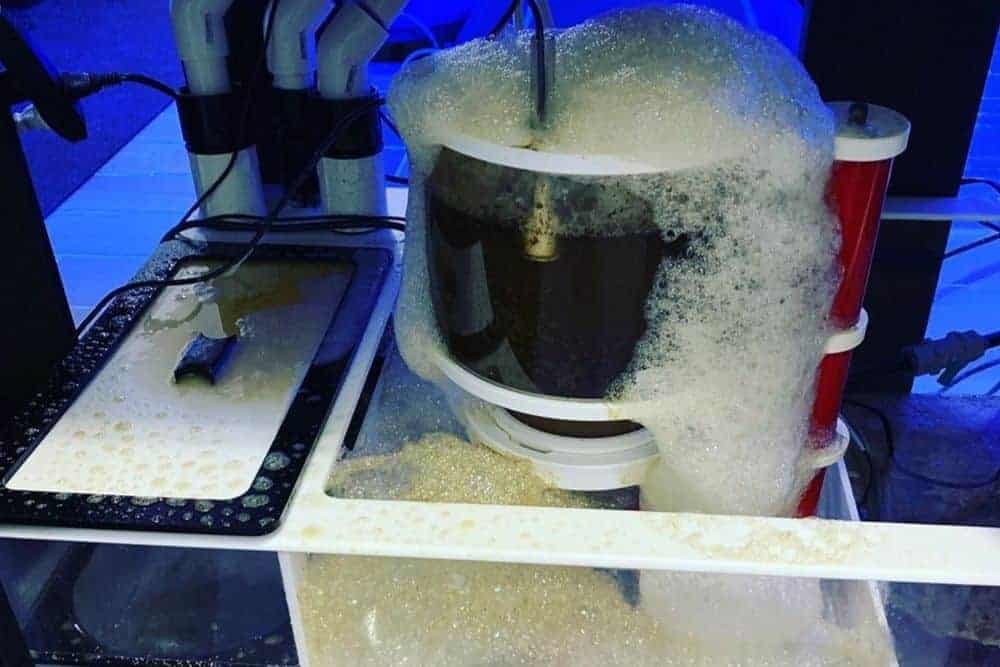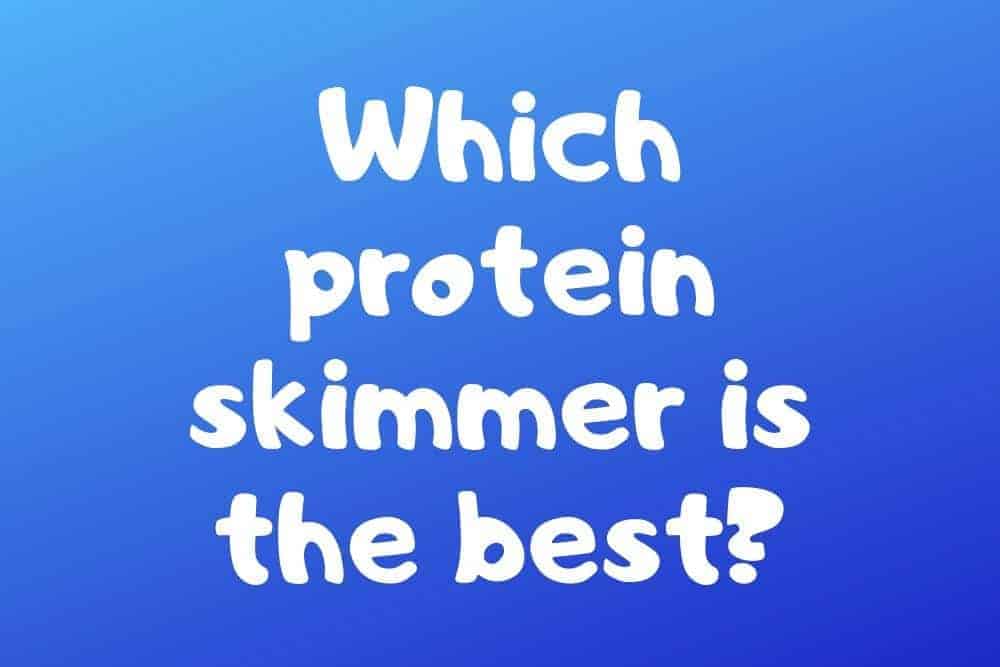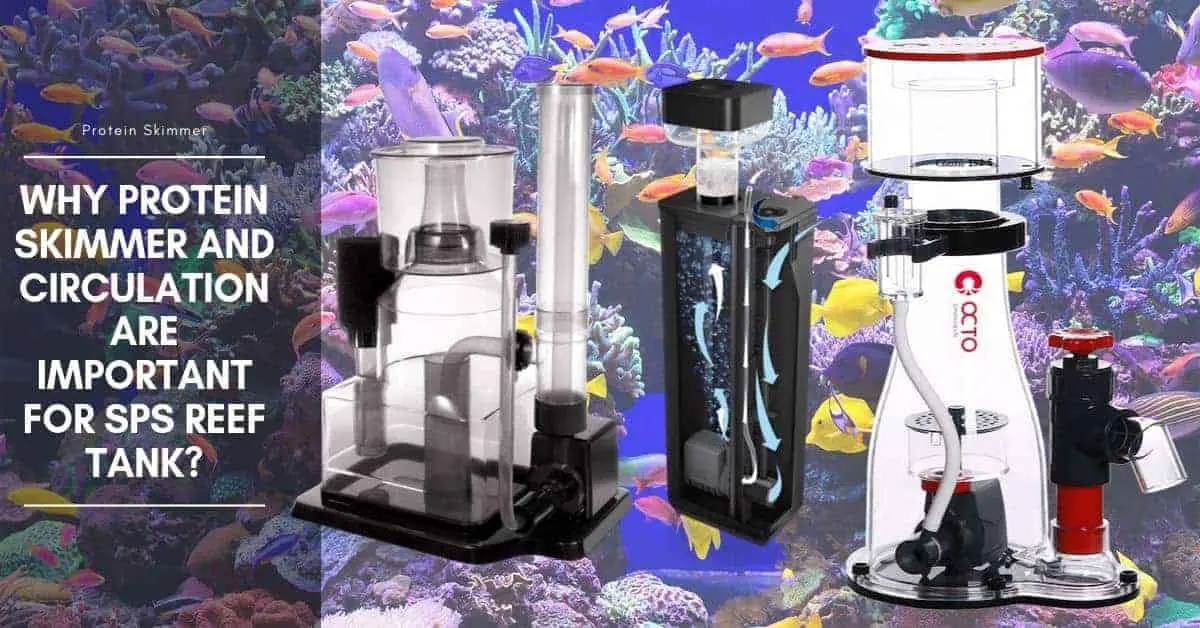A critical and important factor in keeping a thriving SPS dominated reef tank is having a lot of water movement via strong circulation and a good protein skimmer. There are several reasons why. Number one is to avoid ‘dead’ spots and to keep detritus (dead organic matter such as fish waste) from sinking on the bottom of the tank. It helps to keep nitrates and phosphates from building up in the aquarium. Accumulation of these elements can lead to algae outbreaks.
Strong flow also helps to deliver food and nutrients to the corals. Besides strong flow, random flow is also beneficial and can be achieved by hooking pumps up to a controller with preset randomized programs (random flow replicates waves moving across a natural reef).
I am also a believer in having strong surface agitation since it helps to increase oxygen levels and imitates the light refraction in our natural reefs.
SPS coral flow requirements
So what is the right amount of flow to have in an SPS dominated tank? Opinions vary on this, but I would recommend a flow rate in the range of 40-60 gallons per hour (GPH). This is the number of times per hour that the water volume in the display tank is moved. As an example, a 200-gallon tank with a GPH of 10,000 would have a flow rate of 50X.
To maximize flow, I recommend being judicious with pump placement inside the tank and having an open rock structure.
What is the benefit of a protein skimmer in SPS reef tank?
Having an effective protein skimmer is vitally important to maintaining a healthy and thriving SPS dominated reef tank. Skimmers remove organic matter such as fish waste, uneaten food, dying or decaying animals, and problematic algae and bacteria. How do they work? Essentially, a pump pushes water into the column of a skimmer while air is injected, creating a foam. Waste adheres to the air bubbles in the foam and is removed when the foam rises to the top and spills into the collection cup.
API STRESS COAT Aquarium Water Conditioner 16-Ounce Bottle
29% OffAPI STRESS ZYME Freshwater and Saltwater Aquarium Cleaning Solution 1-Ounce Bottle
13% OffAPI ACCU-CLEAR Freshwater Aquarium Water Clarifier 4-Ounce Bottle
18% Off
Types of protein skimmers: pros and cons
There are several types of skimmers one can use:
Air-driven counter current skimmer
The first kind of skimmer available to aquarists was an air-driven counter-current skimmer. These skimmers relied on wooden air diffusers and a high capacity pump to generate bubbles. I used to own one, and it did require a lot of maintenance and constant water height adjustments to get it dialed in.
Downdraft skimmer
A downdraft skimmer, another new design, is typically tall and bulky and needs a reliable pump to create air bubbles. Water is sprayed at high speed into a column that has bio balls. The resulting bubbles flow through the bio balls and then travel into a box where they are pushed up and collected in the neck of the skimmer. Cleaning is not an easy task with this model either, and they are expensive to operate due to the strong pump.
Venturi skimmer
The third type of skimmer is a venturi skimmer, which uses a venturi injector or valve to create air bubbles by drawing air into a water stream. For my reef tank, I used a venturi style skimmer with a Beckett injector, a type of venturi valve. My skimmer had two Beckett injectors and was 50″ tall, a beast, to say the least! The Beckett injectors use more air and create a tremendous amount of foam, generating much more power versus other venturi injectors. This skimmer did an excellent job for me and was very reliable, but the injectors were prone to clogging and had to be cleaned out on a regular basis. On the plus side, this type of skimmer relies on an external pump and does not require a lot of “tuning” to adjust the water level in the skimmer’s chamber.
Aspirating skimmer
An aspirating skimmer is perhaps the most popular form of skimmer in use today. I use one on my tank, and it does a fantastic job. With this skimmer, the air is injected into the impeller cavity of a pump to create bubbles, which are chopped up into more delicate bubbles by an impeller, needle wheel, or pegged wheel. These skimmers are compact and can easily fit inside a sump or underneath a tank stand. They are also easy to set up and maintain. Additionally, they rely on slower water flow and are less expensive to operate since they use low power pumps.
On the downside, there are some durability concerns with certain needle wheel impellers. Some of these units can be tough to dial in, requiring frequent water height adjustments in the chamber when water levels change in the sump.
Protein skimmer maintenance
All skimmers need to be cleaned and maintained on a regular basis to be effective. For essential maintenance on my aspirating skimmer, I clean out my collection cup and upper part of the neck with paper towels once a week.
Self-cleaning head
Self-cleaning heads that sit on top of the collection cup and automatically wipe the inside of the cup on a periodic basis are available to make this cleaning process more comfortable. I have heard claims of some heads being able to improve a skimmer’s efficiency by up to 30%.
Another accessory to consider is some mechanism to prevent skimmate from suddenly overflowing out of the cup and into the tank or sump.
For my latest skimmer, I installed a $10 float switch in my collection cup to shut down the skimmer when skimmate fills the cup. My Neptune Systems Apex Controller is alerted when the switch is triggered and automatically shuts.
In summary

My best advice when it comes to selecting a skimmer is to choose a high-quality one that is very efficient. It has been a big part of my success with SPS.
Don’t assume bigger is better. A skimmer will not be as effective if you use one rated for a large tank on a small aquarium. Why is this the case? Well, to perform optimally, a skimmer should be working all the time. An oversized skimmer will tend to skim well for a few days then slow down once all of the organics have been skimmed out. Once the organics build up again, the skimmer will spring back into action, and thus perform inconsistently.

Hi, my name is Sean, and I’m the primary writer on the site. I’m blogging mostly about freshwater and saltwater aquariums, fish, invertebrates, and plants. I’m experienced in the fishkeeping hobby for many years. Over the years I have kept many tanks, and have recently begun getting more serious in wanting to become a professional aquarist. All my knowledge comes from experience and reading forums and a lot of informative sites. In pursuit of becoming a professional, I also want to inspire as many people as I can to pick up this hobby and keep the public interest growing.
Read more about Sean.
Please join also my Facebook group.




















